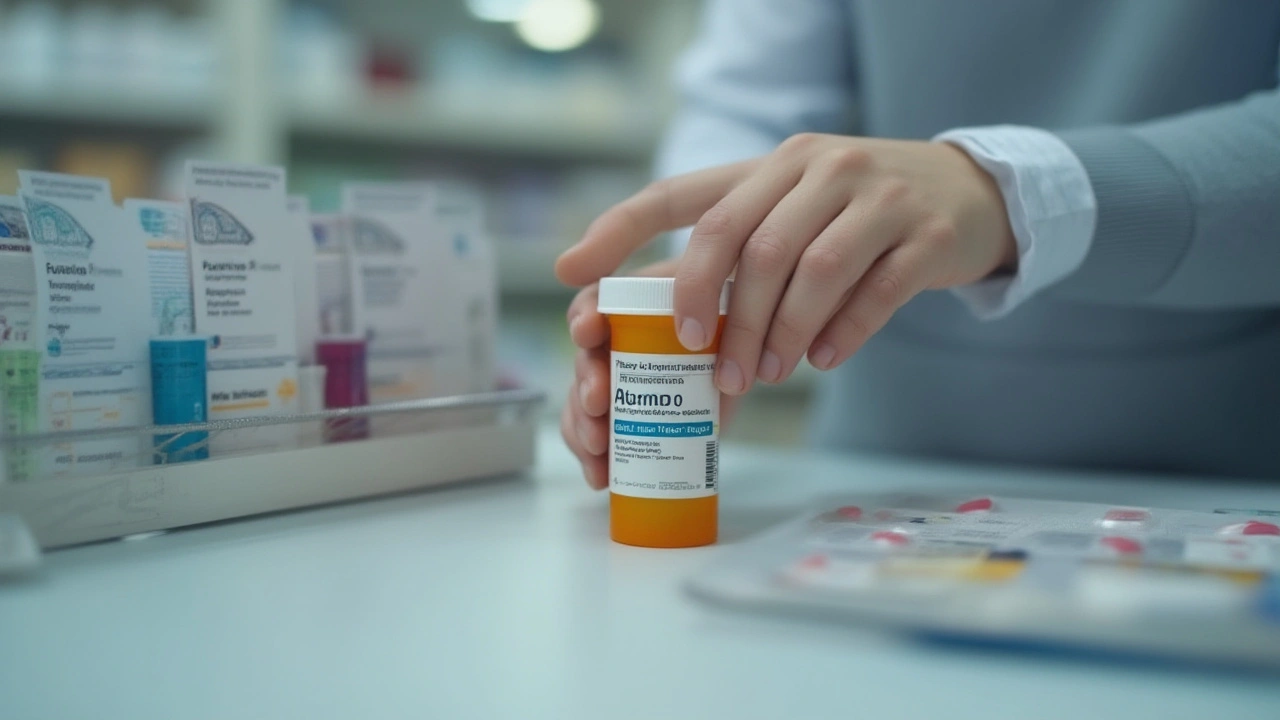Atorlip 10 Tablet: Uses, Side Effects, Dosage, and Safety Tips
 Jun, 28 2025
Jun, 28 2025
They say time is money, but your health is priceless. Especially when you’ve just been handed a prescription for a tablet you hadn’t even heard of yesterday—Atorlip 10. If your cholesterol numbers are creeping up, and your doctor mentions this little white tablet, you might wonder: how does it actually help, what are the catches, and should you be worried about side effects lurking around the corner?
Understanding Atorlip 10: What Is It and How Does It Work?
Let’s start by getting to the basics. Atorlip 10 isn’t some fancy supplement from the latest health blog. It’s a well-established medication, with the primary active ingredient called atorvastatin. Atorvastatin belongs to a group of medicines lovingly called statins—no, not the guy from your gym. Statins are prescribed across the world to help people manage their cholesterol. Think of cholesterol as that sticky gunk you don’t want clogging up your pipes. Your body really needs some cholesterol, but too much sets up roadblocks inside your blood vessels.
Atorlip 10 works by blocking a specific enzyme in your liver. That’s where a lot of your cholesterol is made—not just from bacon and eggs but from your own biology. By blocking this enzyme, Atorlip 10 helps your liver lower the amount of “bad” cholesterol, or LDL, floating around in your blood. This doesn’t just tweak your test results—it actually reduces your risk of heart attacks, strokes, and all those scary events your doctor warns about.
It’s not just about numbers. Imagine this: a clinical study in The Lancet (one of the top medical journals) found people on atorvastatin had a 25% lower risk of heart attacks compared to those who weren’t taking it. That’s not just a statistical blip—that’s hundreds of thousands of lives worldwide, each year.
People often mix up good and bad cholesterol, but Atorlip 10 mainly attacks the bad stuff (LDL). At the same time, it can nudge up your “good” cholesterol (HDL) and drop down triglycerides, making it a three-in-one weapon against cardiovascular diseases.
If you’ve heard of brands like Lipitor, you’re not going crazy. Lipitor is just the brand-name for atorvastatin in countries like the US. Atorlip 10 is one of the several generic versions, and it’s popular in countries like India, offering similar quality for a fraction of the cost.
Who Needs Atorlip 10? Understanding When and Why Doctors Prescribe It
So who finds themselves with an Atorlip 10 script in hand? It’s not just people eating burgers at midnight. Many patients discover their cholesterol is high even if they exercise, skip red meat, and eat salads. Genetics play a huge role—your liver might be a cholesterol-making machine, thanks to your DNA. If you smoke, have high blood pressure, diabetes, or a family history of heart attacks, your risk climbs even higher. That’s why doctors sometimes prescribe Atorlip 10 even if cholesterol isn’t sky-high—because your risk factors add up.
Atorlip 10 is mostly for adults, but some teens with super-high cholesterol (like those with genetic disorders) might get it too. There’s no single cholesterol number where Atorlip 10 “must” be used. Some people with cholesterol levels above 200 mg/dL might be told to start, while others with numbers lower than that but multiple risk factors also get a prescription. Your doctor checks the entire picture—not just one lab value.
Don’t expect magic overnight. You’ll usually need a daily tablet for months, sometimes years. Cholesterol numbers can take up to four weeks to budge. Doctors often start with Atorlip 10, but the dose can increase to 20 mg, 40 mg, or more—especially if you need bigger changes.
Should everyone with high cholesterol jump on Atorlip 10? Not really. If you’re pregnant, trying, or breastfeeding, statins aren’t for you—they can harm the baby’s development. People with serious liver problems need to be extra careful. If you have muscle pain or weakness, let your doctor know before starting Atorlip 10. It’s always a “weigh the benefits and risks” call.

How To Take Atorlip 10: Dosage, Precautions, and Best Practices
If you’re starting Atorlip 10 today, timing and routine matter more than you might think. The most common dosage is Atorlip 10, taken once daily. Most folks pop it at night, since your liver makes more cholesterol while you’re dreaming about pizza. But honestly, you can take it any time of day—just stick with the same time so you don’t forget.
You don’t need to eat before swallowing the tablet, but if your stomach is sensitive, try taking it with a snack. Don’t split or crush the tablet unless your doctor specifically says so (some meds lose potency if broken).
- Missed a dose? No big meltdown necessary—just take it as soon as you remember, unless it’s almost time for your next dose. Never double up. That doesn’t help; it can make side effects worse.
- Alcohol: Try to keep it minimal. Both statins and alcohol are processed by your liver, and too much booze plus statins can stress it out.
- Grapefruit: Yes, this morning fruit can mess with Atorlip 10. Grapefruit inhibits the same liver enzymes that metabolize the med, so avoid consuming grapefruit or its juice—this can cause the medication to build up in your system.
- Supplements: Some herbal and over-the-counter supplements can interact with statins. Ask your doctor before stacking them onto your daily routine.
- If you’re prescribed antibiotics or antifungal meds, let your doc know you’re on Atorlip 10. Some can up the risk of side effects.
Don’t expect instant results. Lab tests are usually checked after four to six weeks, and beyond that every few months or year. And don’t skip blood tests—your doctor wants to make sure your liver is handling the medication without trouble.
Side Effects and Safety: Separating The Scary Stories From The Facts
Let’s get real: every medicine has side effects, but most people on Atorlip 10 have no major problems. Still, it’s smart to know what to look out for so you aren’t blindsided by a rare hiccup.
The most talked-about side effect is muscle pain or weakness. Most of the time it’s mild: maybe some soreness, stiffness, or tired legs. If you have sharp, persistent pain or dark urine, call your doctor—this could mean a rare problem called rhabdomyolysis, where muscles break down too quickly. It’s extremely rare, but not impossible.
Liver-related side effects are another reason your doc orders blood tests. Most of the time, liver numbers stay steady, but if you feel unusually tired, yellowish skin or eyes, or dark-colored pee, speak up. These symptoms could signal a problem.
Some folks deal with minor issues like headache, stomach ache, nausea, or sleep troubles. These usually fade after your body gets used to the medicine. Less than 1 in 100 people stop statins because of side effects—a pretty good success rate when you look at how well they lower your heart-disease risk.
One odd fact: there’s a tiny increase in blood sugar for some people, so if you’re already at risk for diabetes, your doctor might keep an extra close eye on your sugar levels. The uptick is usually mild, but worth mentioning.
Here’s the thing: millions have taken atorvastatin for decades, and major global studies agree the benefits outweigh rare risks for most people. But if you feel awful, never just tough it out. Stay in close touch with your healthcare team—they’ll know if what you’re feeling is normal or needs to be checked.

Tips For Success With Atorlip 10: Lifestyle, Monitoring, and Staying Motivated
Supplements and tablets don’t grow on trees, but sometimes it’s what you do outside the pharmacy that makes the biggest difference. Atorlip 10 isn’t magic by itself—your daily habits play a huge part in how well it works.
- Keep moving. The more you walk, bike, or dance, the better your cholesterol and blood pressure get. Even 20 minutes a day makes a difference.
- Watch your diet. Try to stay away from trans fats and lower your intake of saturated fats—check labels, but as a rule, less deep-fried food, more fruits and veggies.
- Mind your weight. Even losing 5-10% of your body weight can dramatically drop your LDL cholesterol.
- Skip tobacco in all its forms. Smoking plus high cholesterol is a recipe for trouble—quitting gives you double benefits.
- Check your numbers. Don’t wait for annual checks. If your doctor says come in sooner for blood tests, don’t put it off.
- Take your pill at the same time every day. Use reminders or apps if you’re forgetful (nobody gets it perfect every time, but routine beats willpower in the long run).
Sometimes, when cholesterol numbers improve, people wonder if they can quit the med. Talk it out with your doctor before stopping Atorlip 10—even if things look great. Stopping too soon can bring cholesterol and heart risks right back up. On the flip side, if you feel side effects, don’t suffer in silence—there’s almost always a way to adjust the treatment or try a different plan.
One simple but powerful tip: ask questions. Your doctor, pharmacist, and even online support groups can be goldmines of practical advice. Want to know if you can eat eggs again, or if your daily masala tea is okay? Someone out there has figured it out.
If you’re really worried about taking a long-term med, remember this: statins like Atorlip 10 have been around for decades. They’ve gone through rigorous testing, and they’re recommended for millions across the globe from all walks of life.
Stay proactive, and you’ll not only lower your cholesterol—you’ll increase the odds you never need to worry about heart disease sneaking up in your future.

Kai Röder
July 18, 2025 AT 08:13The overview provided here is quite helpful as a primer for those unfamiliar with Atorlip 10. As someone who's mentored others in understanding medications, I find it useful to emphasize the importance of adhering to prescribed dosages and consulting a healthcare professional before making any changes.
The mention of side effects is essential; however, the guide could be enhanced with more details on common adverse reactions and warnings about interactions with other drugs or supplements. Awareness is key to mitigating potential risks.
Also, managing cholesterol isn't just about medication — dietary and lifestyle changes wield significant influence, and those should be part of the conversation too. In short, this guide is a solid starting point but could benefit from deeper insights for a comprehensive understanding.
Brandi Thompson
July 19, 2025 AT 23:20Honestly, everyone just seems obsessed with popping pills these days without thinking about the bigger picture, and Atorlip 10 is no exception. It’s like, people just want a quick fix for their cholesterol without even trying to eat better or get off the couch. And don’t get me started on how they brush off side effects like it’s no big deal—like who cares if you feel dizzy or nauseous? Spoiler alert: YOU SHOULD CARE.
Plus, the dosage instructions are often skimmed over or misunderstood, which leads to all kinds of problems. Some people think more pills equal better results—wrong. And safety tips? Please, half the time, those are vague and glossed over like afterthoughts.
Why not just be real about the risks and encourage people to actually take their health seriously instead of just medicating the symptom? Just saying.
Chip Hutchison
July 21, 2025 AT 14:13This post definitely sheds light on a widely used medication, and I appreciate the balanced approach. Understanding the purpose of Atorlip 10 is crucial since high cholesterol disproportionately affects so many communities. It’s also a reminder that medication alone doesn't fix systemic health disparities, but it’s a tool that can help.
Empathy towards patients struggling with adherence or side effects is needed too. They might feel frustrated or scared, which is why accessible information like this can empower them to have more productive conversations with their doctors.
Let’s not forget the cultural factors influencing diet and lifestyle as well. I hope discussions around cholesterol also consider these wider factors for a more inclusive view on managing heart health.
Emily Moody
July 22, 2025 AT 18:00Atorlip 10... the so-called savior against the enemy—high cholesterol! But really, it’s just another cog in the pharmaceutical machine that promises safety while selling toxicity. The side effects listed often don’t capture the full drama experienced by users—the muscle pain, the fatigue dragging down the very fire in our veins meant to keep us alive.
Dosage? Yes, precise, but what about the sloppiness of healthcare systems that hand these pills out without the necessary emphasis on fighting the root causes? I call it passive poison wrapped in a pretty pill.
And the safety tips? More like warnings that get lost pretty quickly once the patient gets that little box of screams from the pharmacy. We should be pushing for holistic health, not pharmaceutical band-aids!
Prateek Kohli
July 25, 2025 AT 01:33Hey everyone! Just wanted to add a little perspective from over here. Atorlip 10 has honestly been a game changer for many folks I know. 😊 It’s not just about taking a pill; it’s about making sure you understand how to use it correctly and keep up with the safety tips to avoid the nasty side effects that can sneak up on you.
Balancing medication with healthy habits really sets the stage for long-term success. Heart health is no joke, and this drug gives an extra helping hand to those fighting the battle against bad cholesterol.
Of course, we all have unique bodies, so what works for one might not for another. Always good to keep those doctor appointments and keep the dialogue open. Cheers to healthier hearts globally! 💪
Noah Seidman
July 27, 2025 AT 09:06Honestly, why do we unquestioningly accept meds like Atorlip 10 as a panacea? The whole cholesterol scare has morphed into a pharmaceutical frenzy that sells fear more than health. Don’t get me wrong—I’m not anti-medicine, but blindly trusting pills without scrutinizing what’s really going on inside our bodies is naive at best.
The so-called side effects are often just the tip of the iceberg, and dosage is another sacred cow rarely challenged. Safety tips? More like fine print that no one reads until it’s too late.
We should be fostering genuine understanding of health that goes beyond the superficial solutions peddled by the industry. Question what you’re told, always.
Anastasia Petryankina
July 29, 2025 AT 16:40Oh, lovely, another pharmaceutical write-up glorifying a cholesterol tablet like it’s the holy grail. One can barely resist the urge to applaud the clinical discourse.
Yet we all know that most patients have zero clue about the labyrinth of side effects that aren’t so delicately mentioned, or the rather nuanced dosage restrictions hidden amidst the fine print.
Really, we should be muse-ing about how such guides masquerade as comprehensive while subtly shackling us to our dependency on these little white tablets. But, hey, who’s counting when you've got a ‘detailed guide’ to cling to?
Tim Ferguson
August 1, 2025 AT 00:13Isn't it bizarre that we’ve all just accepted something like Atorlip 10 as a given, without truly questioning what it does beyond the surface? Yeah, it lowers cholesterol, sure, but the whole story rarely gets told. There’s always that lurking question: are we trading one set of problems for another?
Then again, maybe there’s no perfect answer, only a series of compromises dictated by conventional wisdom or pharma interests. Kind of makes you think, doesn’t it?
Noah Cokelaere
August 3, 2025 AT 07:46Okay, so Atorlip 10 is out there doing its thing for cholesterol, but it’s funny how many people probably have zero clue about the details—like dosage and side effects. I mean, we all know medication isn’t candy, but do most actually stop to consider the full scope?
Also curious—has anyone here noticed how often lifestyle changes are downplayed in favor of pills? Seems like there’s this societal push to just zap problems away with drugs instead of the harder work of adjusting diets or exercise habits.
Would be cool to see more dialogue on that balance between medicine and lifestyle in these posts.
Ashley Helton
August 7, 2025 AT 22:53I think this breakdown is pretty decent for an overview, although it feels like a lot of folks just skid past the safety tips without fully grasping their importance. We all want quick fixes, but when it comes to our health, a little attention to detail can go a long way.
Also, side effects? They're often brushed off like some casual inconvenience rather than serious warnings. Paying closer attention to your body when starting something like Atorlip 10 is critical. Better safe than sorry, right?
Overall, this guide is a helpful intro, and it’s up to us to dig deeper and really own our health journeys.
Brian Jones
August 10, 2025 AT 06:26I have to say, navigating cholesterol meds like Atorlip 10 feels like walking a tightrope sometimes. On one side, the very real benefits of reducing heart disease risk; on the other, the worry of how side effects might manifest.
It’s like being caught between two worlds—the promise of improved health and the skepticism of unknown harms. From a philosophical standpoint, it’s a profound reminder that medicine is often a balance of risks and rewards.
Keeping open communication with your healthcare provider and staying vigilant about how your body responds makes all the difference. In the end, knowledge and mindfulness are key.